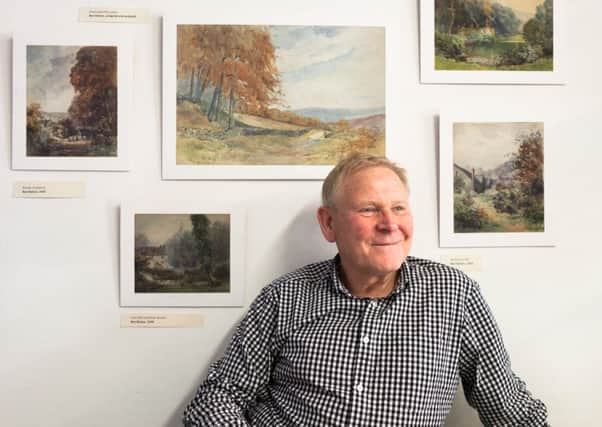Artistry of the working man


Ben Baines earned his living as a Sheffield engineer. A decades-old black-and-white photograph shows him posing next to one of the lathes in his city centre metal-turning workshop. He looks proud and proprietorial, a classic “Little Mester”, a self-employed craftsman with a keen eye for quality and a shrewd head for business.
But, as a new exhibition of a forgotten colony of Sheffield artists shows, this was only part of his story.
Advertisement
Hide AdAdvertisement
Hide Ad“His great passion was painting,” says his grandson, Professor Chris Baines. “And it was always a vexed issue because my grandmother thought it was a complete waste of time.”
When Ben died, Chris – then a schoolboy, now a leading environmentalist – joined his father to clear the old man’s workshop and discovered a cache of other artists’ paintings wrapped in newspaper. He had bought them but had never dared take them home. It’s Ben’s own work, however, that features in the exhibition, part of the ongoing Ruskin in Sheffield project, an inventive celebration of the legacy of the great Victorian social commentator John Ruskin in the city he adopted.
The exhibition is at the Pop-Up Ruskin Museum on the main road through Walkley, where the writer set up his own “people’s museum” in 1875.
It features the work of the Rivelin Valley Artists, a group of part-time painters who, between the wars, explored the landscapes of the valley, to the west of the city.
Advertisement
Hide AdAdvertisement
Hide Ad“This one is from my mum’s living room,” says Sheffield-born Chris, one of the first presenters of the BBC’s Countryfile and now an environmental adviser, writer and broadcaster. It’s a 1947 view towards the Peak District and it has a special significance for him: Ben painted it to celebrate his birth. Some 15 years ago, Chris gathered seeds from the beech trees dominating the picture and planted them in his own garden.
The artisan artists of Rivelin have been called a “colony”, but they didn’t live together; they spent time together. They painted many of the same scenes, often the water-powered mills, forges and workshops dotted along the valley.
Attracted by the valley’s evocative combination of the rural and the industrial; they captured its transformation back from industry to woodland and many of the scenes are still recognisable today.
The Rivelin artists suggest a parallel with the Ashington Group, the so-called Pitmen Painters of the Northumberland coalfield, or even, with a leap of imagination, a St Ives of South Yorkshire. They chimed in with Ruskin’s conviction that working class people – victims of industrial capitalism, as he saw them – should be raised to a greater awareness of the world’s wonders.
Advertisement
Hide AdAdvertisement
Hide AdMost of the Rivelin painters, five of them represented in the exhibition, were amateurs, though their leader and inspiration was a well-known professional – Robert Scott-Temple, who lived in one of the cottages at Rivelin Corn Mill. Known as “The Professor”, he was a Scottish Royal Academician and his accomplished landscapes still sell at US auctions today.
A profile portrait of him in 1921 by the group’s other professional, GWE Goodrich, shows him in flat cap and pince-nez, cigarette holder in his mouth.
Scott-Temple was a great admirer of Ben Baines. “In the folk memory of the family, he said my grandfather was a far better watercolourist than he would ever be,” says Chris. He points to Ben’s gently toned 1935 study of a mill dam) with a smoking-chimneyed mill in the distance. “Grandad said this was his pot-boiler; he could sell as many as he could have painted. He was Ruskin’s ideal: a Sheffield steelworker whose great passions were art and nature.”
After a local radio item about the exhibition, a listener rang Chris to say she owned two pictures by his grandfather. “She said ‘I’d like you to have them. When I die, the kids will just chuck them out; they won’t mean anything to them.’”
Advertisement
Hide AdAdvertisement
Hide AdThe two pictures – a water mill and a shepherd with his sheep – are on show. “I’m confident we’ll get more,” says Chris. “It’s part of the mystery of it; we want people to engage with the exploration.”
People have certainly engaged with the Ruskin in Sheffield project, run by Ruth Nutter. In the Pop-Up Gallery there’s a large-scale map on which 50 or so visitors have highlighted places special to them. “My first student house was there,” begins one “With slugs in the cutlery drawer.”
Drawers and cupboards open to reveal all sorts of things with Ruskinesque resonance: feathers, pebbles, gemstones, a jar of the river water.
“You get people who don’t know each other sitting round the table and talking,” says Ruth. The project has also included an Artists’ Colony-for-a-Day event, encouraging people to paint the Rivelin Valley for themselves, and wooden posts are being erected at places where the artists probably stood to paint. Scanning them through a phone app calls up film of Chris Baines talking about the view. What would Ruskin think about that? “I think he’d be delighted to walk along and be able to see a reproduction of a picture painted a century before,” says Ruth. “Provided he could use the bar code.”
Rivelin Valley Artists exhibition runs until July 16 at the Pop-Up Ruskin Museum, 381 South Road, Walkley. Open Wednesdays, Thursdays & Saturdays. www.ruskininsheffield.com